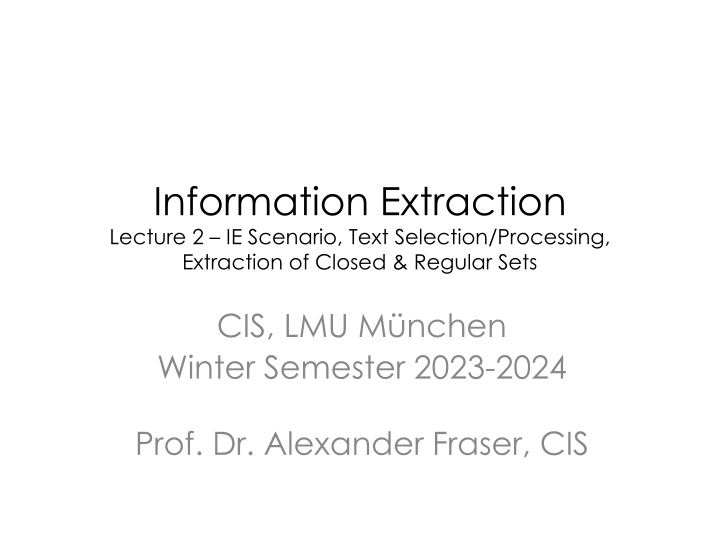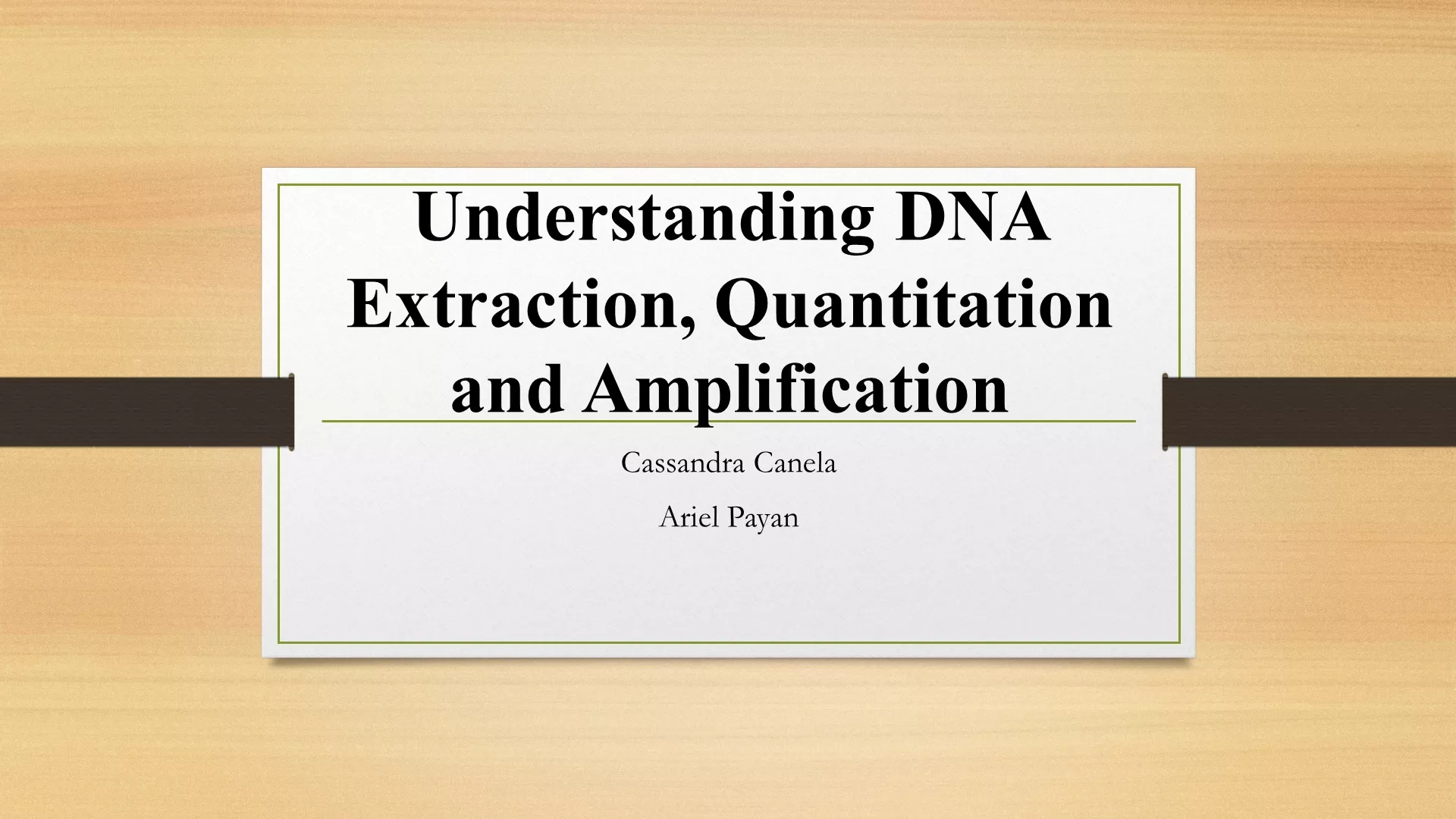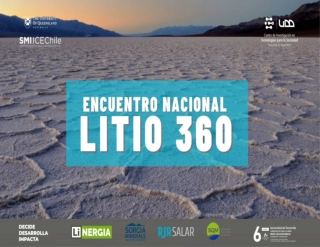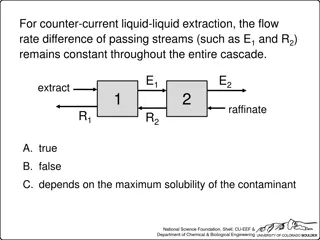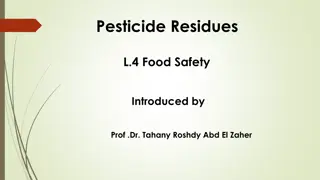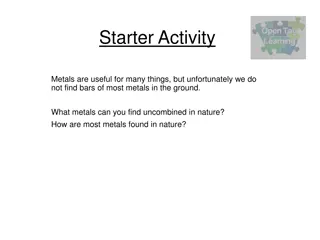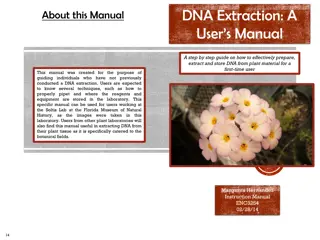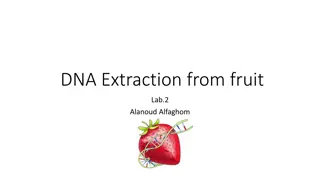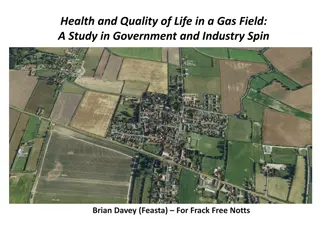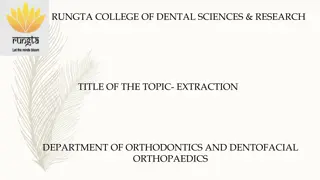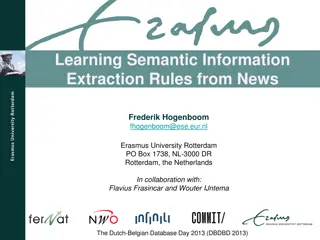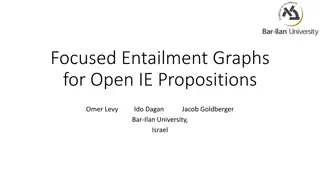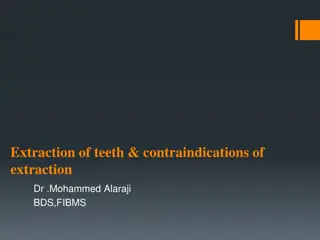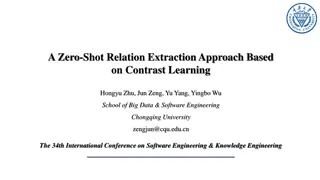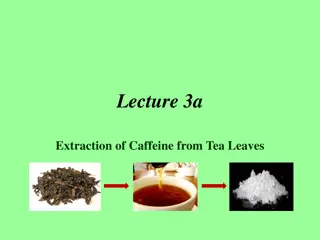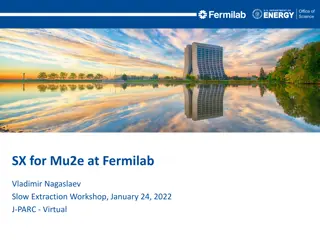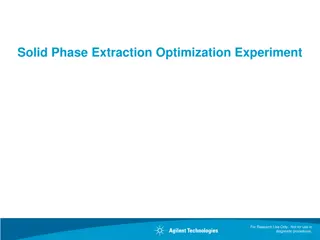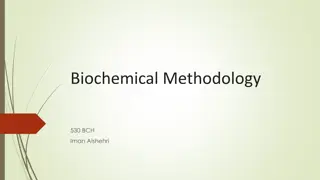Information Extraction
This lecture covers various aspects of information extraction, including scenarios, text selection, processing, and extraction of closed and regular sets. It delves into topics such as source selection, tokenization, normalization, and extraction of entities like dates and country names. The course explores traditional and non-traditional IE scenarios, relation extraction, disease outbreaks, and different types of IE tasks. Students will learn about predefined templates, instance types, and relation types in information extraction, along with practical applications in scenarios like question answering and structured summarization.
Download Presentation

Please find below an Image/Link to download the presentation.
The content on the website is provided AS IS for your information and personal use only. It may not be sold, licensed, or shared on other websites without obtaining consent from the author.If you encounter any issues during the download, it is possible that the publisher has removed the file from their server.
You are allowed to download the files provided on this website for personal or commercial use, subject to the condition that they are used lawfully. All files are the property of their respective owners.
The content on the website is provided AS IS for your information and personal use only. It may not be sold, licensed, or shared on other websites without obtaining consent from the author.
E N D
Presentation Transcript
Information Extraction Lecture 2 IE Scenario, Text Selection/Processing, Extraction of Closed & Regular Sets CIS, LMU M nchen Winter Semester 2023-2024 Prof. Dr. Alexander Fraser, CIS
Administravia I Please check LSF to make sure you are registered Note that CIS students need to be registered for BOTH the Vorlesung and the Seminar (two registrations!) Later in the semester you will have to register yourself in LSF for the Klausur (and to get a grade in the Seminar) Two "Klausur" registrations if you need both grades (most CISlers) 2
Reading for next time Please read Sarawagi Chapter 2 for next time (rule-based NER) 3
Outline IE Scenario Information Retrieval vs. Information Extraction Source selection Tokenization and normalization Extraction of entities in closed and regular sets e.g., dates, country names 4
Relation Extraction: Disease Outbreaks May 19 1995, Atlanta -- The Centers for Disease Control and Prevention, which is in the front line of the world's response to the deadly Ebola epidemic in Zaire , is finding itself hard pressed to cope with the crisis Date Jan. 1995 July 1995 Disease Name Malaria Mad Cow Disease Location Ethiopia U.K. Information Extraction System Feb. 1995 May 1995 Pneumonia Ebola U.S. Zaire Slide from Manning
IE tasks Many IE tasks are defined like this: Get me a database like this For instance, let's say I want a database listing severe disease outbreaks by country and month/year Then you find a corpus containing this information And run information extraction on it 6
IE Scenarios Traditional Information Extraction This will be the main focus in the course Which templates we want is predefined For our example: disease outbreaks Instance types are predefined For our example: diseases, locations, dates Relation types are predefined For our example, outbreak: when, what, where? Corpus is often clearly specified For our example: a newspaper corpus (e.g., the New York Times), with new articles appearing each day However, there are other interesting scenarios... Information Retrieval Given an information need, find me documents that meet this need from a collection of documents For instance: Google uses short queries representing an abstract information need to search the web Non-traditional IE Two other interesting IE scenarios Question answering Structured summarization Open IE IE without predefined templates! Will cover this at the end of the semester 7
Outline Information Retrieval (IR) vs. Information Extraction (IE) Traditional IR Web IR IE Non-traditional IE Question Answering Structured Summarization 8
Information Retrieval Traditional Information Retrieval (IR) User has an "information need" User formulates query to retrieval system Query is used to return matching documents 9
The Information Retrieval Cycle Source Selection Resource Query Formulation Query Search Ranked List Selection Documents query reformulation, vocabulary learning, relevance feedback Documents Examination source reselection Delivery Slide from J. Lin
IR Test Collections Three components of a test collection: Collection of documents (corpus) Set of information needs (topics) Sets of documents that satisfy the information needs (relevance judgments) Metrics for assessing performance Precision Recall Other measures derived therefrom (e.g., F1) Slide from J. Lin
Where do they come from? TREC = Text REtrieval Conferences Series of annual evaluations, started in 1992 Organized into tracks Test collections are formed by pooling Gather results from all participants Corpus/topics/judgments can be reused Slide from J. Lin
Information Retrieval (IR) IMPORTANT ASSUMPTION: can substitute document for information IR systems Use statistical methods Rely on frequency of words in query, document, collection Retrieve complete documents Return ranked lists of hits based on relevance Limitations Answers information need indirectly Does not attempt to understand the meaning of user s query or documents in the collection Slide modified from J. Lin
Web Retrieval Traditional IR came out of the library sciences Web search engines aren't only used like this Broder (2002) defined a taxonomy of web search engine requests Informational (traditional IR) When was Martin Luther King, Jr. assassinated? Tourist attractions in Munich Navigational (usually, want a website) Deutsche Bahn CIS, Uni Muenchen Transactional (want to do something) Buy Lady Gaga Pokerface mp3 Download Lady Gaga Pokerface (not that I am saying you would do this, for reasons of legality, or taste for that matter) Order new Harry Potter book 14
Web Retrieval Jansen et al (2007) studied 1.5 M queries Type Percentage of All Queries Informational Navigational Transactional 81% 10% 9% Note that this probably doesn't capture the original intent well Informational may often require extensive reformulation of queries 15
Information Extraction (IE) Information Extraction is very different from Information Retrieval Convert documents to zero or more database entries Usually process entire corpus Once you have the database Analyst can do further manual analysis Automatic analysis ("data mining") Can also be presented to end-user in a specialized browsing or search interface For instance, concert listings crawled from music club websites (Tourfilter, Songkick, etc) 16
Information Extraction (IE) IE systems Identify documents of a specific type Extract information according to pre-defined templates Place the information into frame-like database records Weather disaster: Type Date Location Damage Deaths ... Templates = sort of like pre-defined questions Extracted information = answers Limitations Templates are domain dependent and not easily portable One size does not fit all! Slide modified from J. Lin
Question answering Question answering can be loosely viewed as "just-in-time" Information Extraction Some question types are easy to think of as IE templates, but some are not Who discovered Oxygen? When did Hawaii become a state? Where is Ayer s Rock located? What team won the World Series in 1992? What countries export oil? Name U.S. cities that have a Shubert theater. Factoid List Who is Aaron Copland? What is a quasar? Definition Slide from J. Lin
An Example Who won the Nobel Peace Prize in 1991? But many foreign investors remain sceptical, and western governments are withholding aid because of the Slorc's dismal human rights record and the continued detention of Ms Aung San Suu Kyi, the opposition leader who won the Nobel Peace Prize in 1991. The military junta took power in 1988 as pro-democracy demonstrations were sweeping the country. It held elections in 1990, but has ignored their result. It has kept the 1991 Nobel peace prize winner, Aung San Suu Kyi - leader of the opposition party which won a landslide victory in the poll - under house arrest since July 1989. The regime, which is also engaged in a battle with insurgents near its eastern border with Thailand, ignored a 1990 election victory by an opposition party and is detaining its leader, Ms Aung San Suu Kyi, who was awarded the 1991 Nobel Peace Prize. According to the British Red Cross, 5,000 or more refugees, mainly the elderly and women and children, are crossing into Bangladesh each day. Slide from J. Lin
Central Idea of Factoid QA Determine the semantic type of the expected answer Who won the Nobel Peace Prize in 1991? is looking for a PERSON Retrieve documents that have keywords from the question Retrieve documents that have the keywords won , Nobel Peace Prize , and 1991 Look for named-entities of the proper type near keywords Look for a PERSON near the keywords won , Nobel Peace Prize , and 1991 Slide from J. Lin
Structured Summarization Typical automatic summarization task is to take as input an article, and return a short text summary Good systems often just choose sentences (reformulating sentences is difficult) A structured summarization task might be to take a company website, say, www.inxight.com, and return something like this: Company Name: Inxight Founded: History: Focus: Information Discovery from Unstructured Data Sources Industry Focus: Enterprise, Government, Publishing, Pharma/Life Sciences, Financial Services, OEM Solutions: Based on 20+ years of research at Xerox PARC Customers: 300 global 2000 customers Patents: 70 in information visualization, natural language processing, information retrieval Headquarters: Sunnyvale, CA Offices: Sunnyvale, Minneapolis, New York, Washington DC, London, Munich, Boston, Boulder, Antwerp 1997 Spun out from Xerox PARC Business Originally from Hersey/Inxight
Non-traditional IE We discussed two other interesting IE scenarios Question answering Structured summarization There are many more For instance, think about how information from IE can be used to improve Google queries and results As discussed in Sarawagi 22
Outline IE Scenario Source selection Tokenization and normalization Extraction of entities in closed and regular sets e.g., dates, country names 23
Finding the Sources Information Extraction ? ... ... ... How can we find the documents to extract information from? The document collection can be given a priori (Closed Information Extraction) e.g., a specific document, all files on my computer, ... We can aim to extract information from the entire Web (Open Information Extraction) For this, we need to crawl the Web The system can find by itself the source documents e.g., by using an Internet search engine such as Google 24 Slide from Suchanek
Scripts Elvis Presley was a rock star. (Latin script) (Chinese script, simplified ) (Hebrew) (Arabic) (Korean script) (Thai script) Elvis Presley 25 Source: http://translate.bing.com Probably not correct Slide from Suchanek
Char Encoding: ASCII ? 100,000 different characters from 90 scripts One byte with 8 bits per character (can store numbers 0-255) How can we encode so many characters in 8 bits? Ignore all non-English characters (ASCII standard) 26 letters + 26 lowercase letters + punctuation 100 chars Encode them as follows: A=65, B=66, C=67, Disadvantage: Works only for English 26 Slide from Suchanek
Char Encoding: Code Pages For each script, develop a different mapping (a code-page) Hebrew code page: ...., 226= ,... Western code page: ...., 226= ,... Greek code page: ...., 226= , ... (most code pages map characters 0-127 like ASCII) Disadvantages: We need to know the right code page We cannot mix scripts 27 Slide from Suchanek
Char Encoding: HTML Invent special sequences for special characters (e.g., HTML entities) è = , ... Disadvantage: Very clumsy for non-English documents 28 Slide from Suchanek
Char Encoding: Unicode Use 4 bytes per character (Unicode) ...65=A, 66=B, ..., 1001= , ..., 2001= Disadvantage: Takes 4 times as much space as ASCII 29 Slide from Suchanek
Char Encoding: UTF-8 Compress 4 bytes Unicode into 1-4 bytes (UTF-8) Characters 0 to 0x7F in Unicode: Latin alphabet, punctuation and numbers Encode them as follows: 0xxxxxxx (i.e., put them into a byte, fill up the 7 least significant bits) A = 0x41 = 1000001 01000001 Advantage: An UTF-8 byte that represents such a character is equal to the ASCI byte that represents this character. 30 Slide from Suchanek
Char Encoding: UTF-8 Characters 0x80-0x7FF in Unicode (11 bits): Greek, Arabic, Hebrew, etc. Encode as follows: 110xxxxx 10xxxxxx = 0xE7 = 00011100111 11000011 10100111 byte byte f a a d e 0x66 0x61 . 0x61 0xE7 01100001 01100110 01100001 11000011 10100111 31 Slide from Suchanek
Char Encoding: UTF-8 Characters 0x800-0xFFFF in Unicode (16 bits): mainly Chinese Encode as follows: 1110xxxx 10xxxxxx 10xxxxxx byte byte byte 32 Slide from Suchanek
Char Encoding: UTF-8 Decoding (mapping a sequence of bytes to characters): If the byte starts with 0xxxxxxx => it s a normal character 00-0x7F If the byte starts with 110xxxxx => it s an extended character 0x80 - 0x77F one byte will follow If the byte starts with 1110xxxx => it s a Chinese character, two bytes follow If the byte starts with 10xxxxxx => it s a follower byte, not valid! 11000011 10100111 01100001 01100110 01100001 f a a 33 Slide modified from Suchanek
Char Encoding: UTF-8 UTF-8 is a way to encode all Unicode characters into a variable sequence of 1-4 bytes Advantages: common Western characters require only 1 byte ( ) backwards compatibility with ASCII stream readability (follower bytes cannot be confused with marker bytes) sorting compliance In the following, we will assume that the document is a sequence of characters, without worrying about encoding 34 Slide from Suchanek
Language detection How can we find out the language of a document? Elvis Presley ist einer der gr ten Rockstars aller Zeiten. Different techniques: Watch for certain characters or scripts (umlauts, Chinese characters etc.) But: These are not always specific, Italian similar to Spanish Use the meta-information associated with a Web page But: This is usually not very reliable Use a dictionary But: It is costly to maintain and scan a dictionary for thousands of languages 35 Slide from Suchanek
Language detection Histogram technique for language detection: Count how often each character appears in the text. German corpus: French corpus: Document: Elvis Presley ist a b c ... a b c ... similar a b c ... not very similar Then compare to the counts on standard corpora. 36 Slide from Suchanek
Sources: Structured Name D. Johnson J. Smith S. Shenker Y. Wang J. Lee A. Gupta R. Rivest Number 30714 20934 20259 19471 18969 18884 18038 Information Extraction Name D. Johnson J. Smith ... Citations 30714 20937 ... File formats: TSV file (values separated by tabulator) CSV (values separated by comma) 37 Slide from Suchanek
Sources: Semi-Structured <catalog> <cd> <title> Empire Burlesque </title> <artist> <firstName> Bob </firstName> <lastName> Dylan </lastName> <artist> </cd> ... Information Extraction Title Empire Burlesque ... Artist Bob Dylan ... File formats: XML file (Extensible Markup Language) YAML (Yaml Ain t a Markup Language) 38 Slide from Suchanek
Sources: Semi-Structured <table> <tr> <td> 2008-11-24 <td> Miles away <td> 7 </tr> ... Information Extraction Title Miles away ... Date 2008-11-24 ... File formats: HTML file with table (Hypertext Markup Lang.) Wiki file with table (later in this class) 39 Slide from Suchanek
Sources: Unstructured Founded in 1215 as a colony of Genoa, Monaco has been ruled by the House of Grimaldi since 1297, except when under French control from 1789 to 1814. Designated as a protectorate of Sardinia from 1815 until 1860 by the Treaty of Vienna, Monaco's sovereignty Information Extraction Event Foundation ... Date 1215 ... File formats: HTML file text file word processing document 40 Slide from Suchanek
Sources: Mixed Information Extraction <table> <tr> <td> Professor. Computational Neuroscience, ... ... Name Barte ... Title Professor ... Different IE approaches work with different types of sources 41 Slide from Suchanek
Source Selection Summary We can extract from the entire Web, or from certain Internet domains, thematic domains or files. We have to deal with character encodings (ASCII, Code Pages, UTF-8, ) and detect the language Our documents may be structured, semi-structured or unstructured. 42 Slide from Suchanek
Information Extraction Information Extraction (IE) is the process of extracting structured information from unstructured machine-readable documents Person Name Person Type ? Instance Extraction Source Selection Elvis Presley musician Angela Merkel politician 05/01/67 1967-05-01 Tokenization& Normalization Fact Extraction Relation Entity1 Entity2 Married Elvis Presley Priscilla Beaulieu CEO Tim Cook Apple Named Entity Recognition And Beyond! ... married Elvis on 1967-05-01 Ontological Information Extraction Tip of the hat: Suchanek
Tokenization Tokenization is the process of splitting a text into tokens. A token is a word a punctuation symbol a url a number a date or any other sequence of characters regarded as a unit In 2011 , President Sarkozy spoke this sample sentence . 44 Slide from Suchanek
Tokenization Challenges In 2011 , President Sarkozy spoke this sample sentence . Challenges: In some languages (Chinese, Japanese), words are not separated by white spaces We have to deal consistently with URLs, acronyms, etc. http://example.com, 2010-09-24, U.S.A. We have to deal consistently with compound words hostname, host-name, host name Solution depends on the language and the domain. Naive solution: split by white spaces and punctuation 45 Slide from Suchanek
Normalization: Strings Problem: We might extract strings that differ only slightly and mean the same thing. Elvis Presley ELVIS PRESLEY singer singer Solution: Normalize strings, i.e., convert strings that mean the same to one common form: Lowercasing, i.e., converting all characters to lower case Removing accents and umlauts r sum resume, Universit t Universitaet Normalizing abbreviations U.S.A. USA, US USA 46 Slide from Suchanek
Normalization: Literals Problem: We might extract different literals (numbers, dates, etc.) that mean the same. Elvis Presley Elvis Presley 1935-01-08 08/01/35 Solution: Normalize the literals, i.e., convert equivalent literals to one standard form: 1.67m 1.67 meters 167 cm 6 feet 5 inches 08/01/35 01/08/35 8th Jan. 1935 January 8th, 1935 1.67m 1935-01-08 47 Slide from Suchanek
Normalization Conceptually, normalization groups tokens into equivalence classes and chooses one representative for each class. resume 1935-01-08 r sum , resume, Resume 8th Jan 1935, 01/08/1935 Take care not to normalize too aggressively: bush Bush 48 Slide from Suchanek
Caveats Even the "simple" task of normalization can be difficult Sometimes you require information about the semantic class If the sentence is "Bush is characteristic.", is it bush or Bush? Hint, you need at least the previous sentence... 49
Information Extraction Information Extraction (IE) is the process of extracting structured information from unstructured machine-readable documents Person Name Person Type ? Instance Extraction Source Selection Elvis Presley musician Angela Merkel politician 05/01/67 1967-05-01 Tokenization& Normalization Fact Extraction Relation Entity1 Entity2 Married Elvis Presley Priscilla Beaulieu CEO Tim Cook Apple Named Entity Recognition And Beyond! ... married Elvis on 1967-05-01 Ontological Information Extraction Tip of the hat: Suchanek
